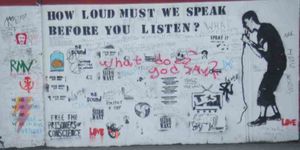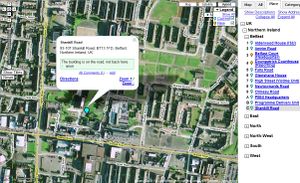Difference between revisions of "Web 2.0"
(→Learning from each other: engaging stakeholders using Web 2.0) |
(→Learning from each other: engaging stakeholders using Web 2.0) |
||
| Line 8: | Line 8: | ||
*[[What is new about Web 2.0?]] | *[[What is new about Web 2.0?]] | ||
| − | *Uses of Web 2.0 in e-government | + | *[[Uses of Web 2.0 in e-government]] |
*Our work on e-consultation: [http://wiki.e-consultation.org/ study group] and [http://www.e-consultation.org/ research project] | *Our work on e-consultation: [http://wiki.e-consultation.org/ study group] and [http://www.e-consultation.org/ research project] | ||
*E-consultation and Web 2.0 | *E-consultation and Web 2.0 | ||
*Developing lasting relationships | *Developing lasting relationships | ||
| − | |||
| − | |||
| − | |||
| − | |||
| − | |||
| − | |||
| − | |||
| − | |||
| − | |||
| − | |||
| − | |||
| − | |||
| − | |||
| − | |||
===E-consultation and Web 2.0=== | ===E-consultation and Web 2.0=== | ||
Revision as of 21:14, 20 November 2007
What is Web 2.0, and how can it be used to engage citizens and stakeholder groups in governance?
That is the theme of a talk Dr. David Newman gave at the IT in Government 2007, Northern Ireland conference.
Contents
Learning from each other: engaging stakeholders using Web 2.0
How do know that your customers are satisfied with your services? Should you be doing things differently? What do stakeholders want from government? To find out, you need to engage citizens. We now have ICTs that you can use to learn from stakeholders. With two-way communication, people don't just read what you tell them, but can tell you what they think is important. Dr. Newman will show how Web 2.0 tools can be used to acquire and manage knowledge from many people inside and outside your organisation, based on his extensive research into e-consultation.
- What is new about Web 2.0?
- Uses of Web 2.0 in e-government
- Our work on e-consultation: study group and research project
- E-consultation and Web 2.0
- Developing lasting relationships
E-consultation and Web 2.0
Compare these two sites:
- A very traditional web site that,
- puts on-line the paper-based process,
- requires people to read long PDFs in sometimes difficult language
- in most cases expects written replies on paper.
- A story-collecting site that,
- collects personal experiences of what it is to be an active citizen in Ireland,
- used to build up a more subtle picture of today's citizens,
- to include in a submission to the Taoiseach's Taskforce on Active Citizenship.
Collecting stories
The second is the Web 2.0 approach. It encourages ordinary people and workers to tell stories of what they think is important, rather than just answer the questions that officials worry about. Here we see reflective citizenship at its best.
To succeed, such approaches require:
- A willingness to listen to stakeholders in their own words, and reflect on what you hear.
- Publicity to establish awareness among the stakeholder group.
- (in this case, via the community and voluntary sector members of The Wheel)
- A clear web site inviting visitors to participate.
- Very easy ways of submitting content
- (in this case, multiple channels: web forms, e-mail, SMS text messages and voice mail recordings)
Another example is Patient Opionion, which collects opinions and experiences from users of NHS services.
Discussing issues
Once you have discussions on a site, people can explore problems and suggest solutions.
- Issues forums
- have been developed for people to discuss local issues,
- some of which are then taken up by officials or councillors,
- to raise officially in council debates and committee hearings.
Mapping opinions
We tried comparing conventional consultation with a Google maps mash-up.
- The topic was the Probation Board consulation on their estates review.
- Which probation offices or reporting centres should be closed, moved or opened.
- They wanted the views of ex-offenders,
- some of whom could barely read or write
- We compared:
- the conventional consultation document and response form, with
- getting ex-offenders to add comments to markers on Google maps.
- Community Walk map of NI probation office locations

